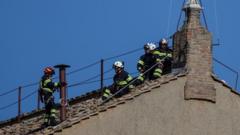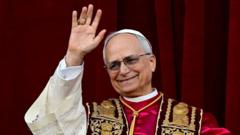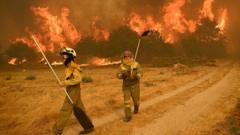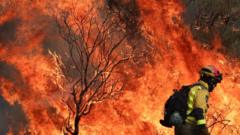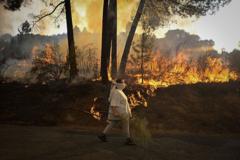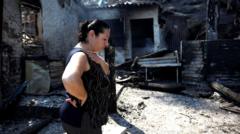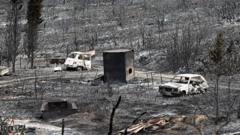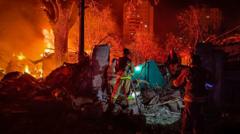When the Catholic Church is set to elect a new pope, observers around the globe turn their attention to a small chimney perched atop the Sistine Chapel, awaiting the ascendance of smoke. The outcome of the papal election is dramatically conveyed through this smoke: black indicates no decision has been reached, while white confirms a new pope has been selected with the proclamation "Habemus Papam."
Behind the high-profile event witnessed by millions lies a complex orchestration of engineering and ceremonial practices. Experts reveal that the process involves two specially designed firework-like mechanisms, comprehensive smoke tests, and Vatican firefighters on alert. As Pope Francis passed away this Easter at 88, the spotlight has shifted towards the upcoming conclave set for May 7, when cardinals will convene in St Peter's Basilica before entering the chapel for voting.
The custom of burning ballots has been entrenched in the process since the 15th Century to promote transparency and mitigate past frustrations stemming from election delays. Smoke became the Vatican's means of communicating with observers outside, all while safeguarding the vote's secrecy – a blend of tradition and modern need.
Academics highlight the significance of smoke as a historical medium for human connection to the divine, with rising smoke fundamentally linked to religious rituals. It embodies a sense of unity among the crowd in St Peter's Square, immersing them in this confidential process.
The Sistine Chapel is host to complex machinery during the conclave, with dual stoves — one designated for burning ballots and the other for generating the smoke signals. Technicians ensure a carefully constructed flue channels smoke discreetly into the world outside, as workers assemble stoves and secure the chimney — a feat requiring considerable precision within the historic chapel adorned with Michelangelo's masterpieces.
Each phase of setup, conducted in the days leading to the event, involves rigorous testing to ensure the smoke signals function properly. This precise execution is vital because a malfunction could have lasting diplomatic repercussions.
Vatican engineers utilize a mix of chemical compounds to create distinct smoke effects: black smoke results from burning potassium perchlorate, anthracene, and sulfur, while white smoke arises from potassium chlorate, lactose, and pine rosin. This modern approach to smoke generation, previously muddled by the use of straw, aims to eliminate confusion. Electronic ignition of these mixtures prevents ambiguity, ensuring a clear message is relayed.
In addition to the smoke, bell ringing—a practice adopted during Pope Benedict XVI's papacy—adds an extra layer of confirmation to the signal. Despite suggestions for modernization, the Vatican appears committed to its time-honored methods, viewing them as vital connections to the Church’s history.
In conclusion, the Vatican's enduring smoke signal tradition serves not only as communication but also encapsulates deeper theological significance. As challenged modernity looms, the Church maintains its ritualistic integrity amid global anticipation for the announcement of a new pope.
Behind the high-profile event witnessed by millions lies a complex orchestration of engineering and ceremonial practices. Experts reveal that the process involves two specially designed firework-like mechanisms, comprehensive smoke tests, and Vatican firefighters on alert. As Pope Francis passed away this Easter at 88, the spotlight has shifted towards the upcoming conclave set for May 7, when cardinals will convene in St Peter's Basilica before entering the chapel for voting.
The custom of burning ballots has been entrenched in the process since the 15th Century to promote transparency and mitigate past frustrations stemming from election delays. Smoke became the Vatican's means of communicating with observers outside, all while safeguarding the vote's secrecy – a blend of tradition and modern need.
Academics highlight the significance of smoke as a historical medium for human connection to the divine, with rising smoke fundamentally linked to religious rituals. It embodies a sense of unity among the crowd in St Peter's Square, immersing them in this confidential process.
The Sistine Chapel is host to complex machinery during the conclave, with dual stoves — one designated for burning ballots and the other for generating the smoke signals. Technicians ensure a carefully constructed flue channels smoke discreetly into the world outside, as workers assemble stoves and secure the chimney — a feat requiring considerable precision within the historic chapel adorned with Michelangelo's masterpieces.
Each phase of setup, conducted in the days leading to the event, involves rigorous testing to ensure the smoke signals function properly. This precise execution is vital because a malfunction could have lasting diplomatic repercussions.
Vatican engineers utilize a mix of chemical compounds to create distinct smoke effects: black smoke results from burning potassium perchlorate, anthracene, and sulfur, while white smoke arises from potassium chlorate, lactose, and pine rosin. This modern approach to smoke generation, previously muddled by the use of straw, aims to eliminate confusion. Electronic ignition of these mixtures prevents ambiguity, ensuring a clear message is relayed.
In addition to the smoke, bell ringing—a practice adopted during Pope Benedict XVI's papacy—adds an extra layer of confirmation to the signal. Despite suggestions for modernization, the Vatican appears committed to its time-honored methods, viewing them as vital connections to the Church’s history.
In conclusion, the Vatican's enduring smoke signal tradition serves not only as communication but also encapsulates deeper theological significance. As challenged modernity looms, the Church maintains its ritualistic integrity amid global anticipation for the announcement of a new pope.

